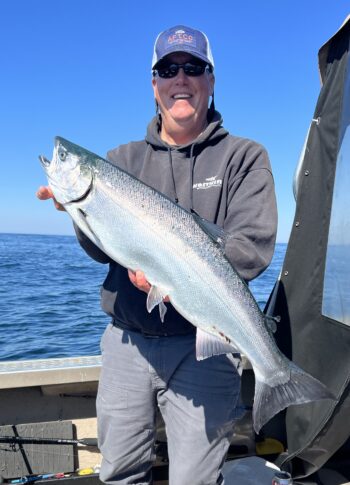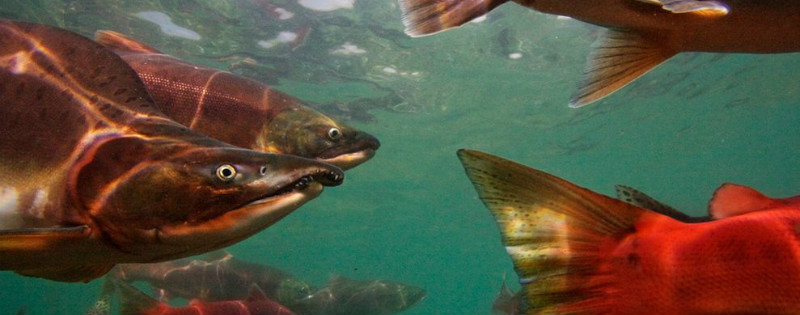
Bob Rees with a large wild coho, taken about 18 miles offshore of Newport, Oregon on September 22, 2023
When I first started my guide business over 27 years ago, I knew switching professions from a field biologist that strived to conserve salmon, to becoming reliant on the health of a natural resource for consumptive use, was a risk. I was willing to accept that risk because, hey, I was skipping out of work early to go fishing anyway, and how long was my employer going to play along with that? Thankfully, they were quite understanding, maybe to a fault.
If I had stayed the course with my job at the Oregon Department of Fish and Wildlife (ODFW), I’d be a “Tier 1” PERS (Public Employee Retirement System) retiree at age 50 (I’m 55 now), but would I have been as fulfilled as I feel now? I don’t think so.
I often debate with my fellow anglers about the performance of our natural resource agencies. Granted, I have a bias as I was once employed by the agency, and still have numerous friends that still work for state and federal natural resource agencies. My biased opinion is, however, we have an enormous number of dedicated people, who have a genuine interest in our resource, our industry and our communities, working in our government agencies. They are bright and very capable.
That said, our natural resources continue to suffer. (That sentence deserves its own paragraph.)
Maybe the saddest fact of all is that I’ve witnessed a precipitous decline in our most iconic fish, and therefore our opportunity to pursue these fish and be true ambassadors to the next generation of conservationists, all in the last 30 years. Yes, I’ve had the pleasure of sitting with the old timers and heard how it used to be, but we had some darned good fishing when I first started my guide business in 1996 and well into the 2000’s too.
Maybe the first red flag came when, in my first 10 years, Oregon anglers lost what I call “consumptive access” (the ability to retain) to 5 of the 6 species of wild salmon and steelhead on the north Oregon Coast. I questioned myself, leaving a good job with a bright future, when I just lost over 83 percent of my “product” when I was just getting started.
As I’ve written about before, salmon and steelhead runs have become the victims of a thousand cuts, but one can’t overlook the fact that on the north coast, no dams are impeding the recovery of these species, such as they are on the Columbia River system. Schooled in fish husbandry, we learned early how salmon behavior and success is directly linked to water temperatures. When every major river system on the north coast fails to meet the minimum temperature for the spawning and rearing of wild fish, it’s pretty easy to see where our problem lies.
Do you think it’s any coincidence that wild cutthroat, coho, steelhead and adult spring Chinook are on the ropes and that these species, through their life history evolution, REQUIRE them to spend at least one summer in our freshwater ecosystems? When temperatures exceed 67°F, these fish start to suffer. When temperatures exceed 70°F, these fish start to die. North coast water temperatures frequently exceed 70°F for several weeks at a time between mid-July and mid-August. We don’t have snow-pack to cool these systems; there is no reprieve.
Fortunately, we have an opportunity with these wild salmon and steelhead.
This winter, the Board of Forestry is going to decide whether or not to move forward with a Habitat Conservation Plan that addresses the needs of species of concern, such as our wild salmon and steelhead. In my and many others’ opinions, it’s the only pathway forward to recovery for these imperiled species. Several rockfish species are also incorporated into this list of concerned species, and I have no real answers other than we simply went hands-off on a large swath of the ocean for a relatively long period of time.
Rockfish Conservation Areas were developed when the fishery collapsed in the early 1990’s and, to some extent, remain in place today. Some “20,000 square miles along the entire length of the West Coast were closed to the groundfish trawl fleet.” This allowed habitats to somewhat recover, but most importantly, stopped the gross over-harvest of most groundfish species with the stroke of a pen. I was with ODF&W at that time too and remember how somber the office was in Astoria when this news came down.
Thirty years later, we continue to see the liberalization of sportfishing bag limits and even more extended opportunities for trawlers, while being mindful of the historic destruction that happened with trawl gear over the decades. This web site tells a pretty cool history of the recovery.
Once again, the Magnuson-Stevens Act is due credit for these successes. The Act is well overdue for reauthorization, but with the dysfunction in Congress right now, it seems pretty far out of reach. It was tough to pass this sensible legislation when Congress was IN session. I’ll remind readers that Warren Magnuson was a Democrat in Washington and Ted Stevens a stout Republican from Alaska. Two opposing party members working in unison for land-mark legislation that saved the industry and saved a multitude of marine species from the brink of extinction.
I’ll close this piece with the hard-hit reality of what’s happening to the trade (for me) and passion (for outdoorsmen and women) on the West Coast. Sportfishing is in jeopardy.
What used to be a 150 day/year opportunity for my business and my clientele, has been cut by two-thirds. With Tillamook Chinook and winter steelhead in the toilet, catch and keep sturgeon off the table, abysmal returns of spring and summer Chinook as well as summer steelhead, I now have 50 meaningful days of fishing to feed my family and my community. We’re no longer full-time fishing guides, restaurants and tackle stores, and even the famed Ghost Hole in Tillamook Bay is void of sport angling effort. We used to provide the shoulder season crowds for rural Oregon and Washington. Now we’re closed or severely restricted in many of the historic fisheries that used to fuel its own little macro-economic engine for the Oregon Coast. We, too, are on the ropes.
Challenges are coming at us from all angles. From lethal summer water temperatures on our public forestlands, to the collapse of the food base for critical marine species, to unknown changes in ocean temperatures and acidification, we have a lot to fix. Staving off change is already too late; we need methods and strategies to reverse the damage we’ve done, and it only comes from collaboration. We’re at a crossroads, with no real roadmap to righting the listing vessel.
Let’s ask our elected leaders for leadership, and even though there is an abundance of issues that draw attention away from natural resource policy, it’s up to us to keep it as a priority.
On a bright note, literally, pictured above is me, holding a large wild coho, taken about 18 miles offshore of Newport, Oregon on September 22, 2023. This year, anglers got to take advantage of some excellent fishing for wild coho, also once on the brink of extinction, with (recent) historical opportunity in our offshore fisheries. This prime wild fish and five others, plus two hatchery fish, to round out our limit in about 70 minutes, was taken on spinner/chunk bait rigs and flashers in about 200 feet of water after we came up short on our halibut effort.
If we continue to have such rare opportunity to enjoy such a unique resource, these special days become even more meaningful. It also means, however, that fewer people will get a chance to enjoy them, compromising the future foot soldiers we need to keep the dream alive.


